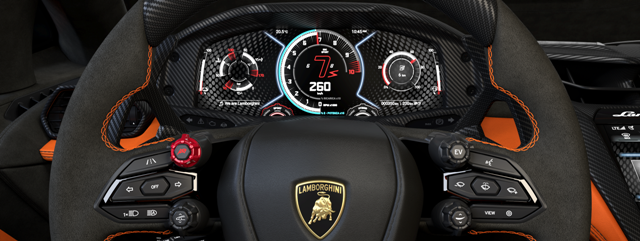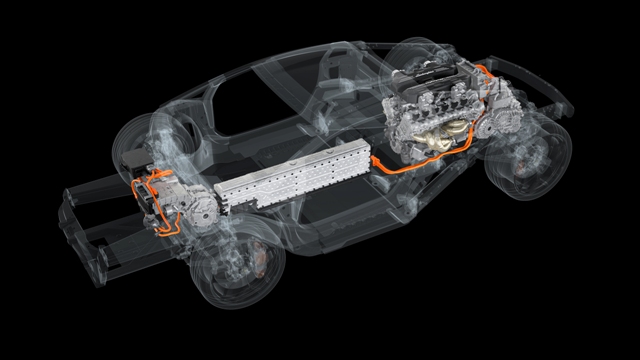
Lamborghini LB744
Just a few days before the premiere of the first V12 HPEV (High Performance Electrified Vehicle) hybrid super sports car, Lamborghini gives an insight into the car’s driving dynamics. The new car, project name LB744, is designed and developed to deliver absolute excitement and control in all situations and in all grip conditions, providing the driver with a level of confidence and connection with the car never experienced before.
The innovations that place the LB744 at the apex of its category include the architecture and balance of the car; the cutting-edge approach to the chassis and the aerodynamic design; and the new hybrid powertrain that makes it possible to maximize the electric motor support and introduce new driving modes, including zero-emission 4WD, for a total of 13 different driving experiences.
The car features an unprecedented layout: a 6.5-liter naturally aspirated V12 mid-engine, three electric motors, two of which are located on the front e-axle and one integrated into the new 8-speed dual-clutch transmission, arranged for the first time behind the combustion engine and transversely to the V12. The tunnel, a space traditionally reserved for the gearbox since the era of the Countach, is now the location of a new lithium-ion battery with high specific power that drives the electric motors.
The new architecture allows for optimal weight distribution (44% at the front and 56% at the rear), bringing them closer to the center of gravity and optimizing the length of the wheelbase, resulting in a perfect balance that makes the LB744 extremely agile and effective both on the road and in the curves of a circuit. This capability is also enhanced by the increased stiffness of the anti-roll bars (+11% at the front and +50% at the rear), and by the reduced steering ratio (-10% compared to the Aventador Ultimae): an approach already successfully tested on the Huracán STO[1]. The LB744’s capabilities are complemented by the four-wheel steering system, which contributes significantly to the sensation of a car that is agile, responsive and compact but at the same time stable and precise, and by the specially developed Bridgestone Potenza Sport tires featuring a more generous front footprint (+4% compared to the Aventador).

Thanks to the e-axle, with the LB744 Lamborghini introduces electric torque vectoring for the first time in its history and inaugurates the Lamborghini Dinamica Veicolo 2.0 system. Electric torque vectoring increases the car’s agility in narrow cornering as well as its stability in high-speed cornering, distributing torque optimally to each wheel and working in synergy with the four-wheel steering system. In addition, unlike conventional systems, the new torque vectoring intervenes on the brakes only when strictly necessary, to maximize efficiency and ensure a more natural driving style as well as an even higher level of performance. When braking, the e-axle and rear electric motor contribute to deceleration, reducing stress on the brakes while recharging the battery.
The chassis also makes a substantial contribution to the vehicle dynamics. The LB744 is the first Lamborghini to be equipped with the new aviation-inspired monofusolage, an ultra-lightweight integral carbon fiber structure (weighing 10% less than the Aventador chassis) that combines high performance in energy absorption with increased torsional stiffness (+25% compared to the Aventador), making the LB744 exceptionally stable and contributing to the car’s overall feeling of compactness and responsiveness.
Active aerodynamics play an essential role, achieving new levels of efficiency and downforce: +61% and +66%, respectively, in high-load situations compared to the Aventador Ultimae, especially thanks to the front splitter and roof design that channels air flow to the high-efficiency rear wing. The aerodynamics work in synergy with the semi-active wishbone suspension, controlled by the Lamborghini Vertical Control system designed specifically for the LB744, which electronically manages vertical force exchanges such as sudden load transfers during track driving, adapting the suspension and rear wing behavior in real time.
To respond to the highest performance situations, the braking system and brake cooling system have also been redesigned. The car features latest generation CCB Plus (Carbon Ceramic Brakes Plus). The front calipers with ten pistons instead of six, are combined with 410x38mm discs (in place of the previous 400x38mm of Aventador Ultimae); at the rear are 4-piston calipers and 390x32mm discs (in place of the previous 380x38mm). Discs are covered by a friction layer for a better performance, thermal management and acoustic comfort when braking.
Aerodynamics contribute to the system’s efficiency, as the pair of front suspension deflectors and the grille inside the wheel arches are designed to improve not only the cooling of the front brakes – the strip draws air from the front diffuser and channels it to the brake – but they are shaped to reduce resistance inside the wheel well, limiting any compression phenomena, while increasing the load at the front. In addition, the two NACA ducts located in front of the rear wheels collect flow from the underbody and direct it to the rear brake cooling duct.
Debuting along with the hybrid system are three new dedicated driving modes: Recharge, Hybrid and Performance, to be combined with the Città (City), Strada, Sport and Corsa modes, selectable via the two rotors located on the redesigned steering wheel, for a total of 13 dynamic settings that highlight the LB744’s different personalities and potential depending on the situation and the type of road, or track, on which it’s driven.
Information Source: Read More “
Energy Monitors , Electric Power , Natural Gas , Oil , Climate , Renewable , Wind , Transition , LPG , Solar , Electric , Biomass , Sustainability , Oil Price , Electric Vehicles,


